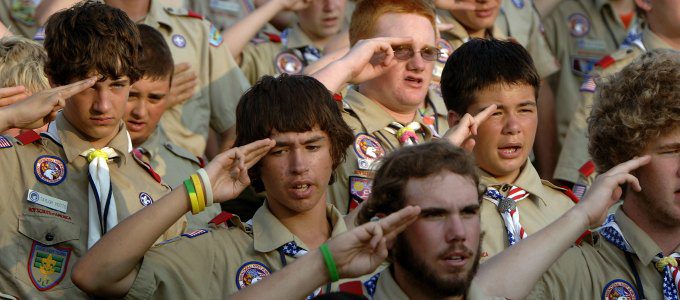The Boy Scouts of America wear their achievements literally on their sleeves, as well as carry them in their pockets via digital badging. (Photo courtesy of the U.S. Navy)
Instead of pointing to each patch on their vests, the Boy Scouts of America might prefer to show off their achievements with the swipe of a smartphone screen.
That’s because BSA’s merit program is adapting to digital-native members by adopting digital badging, a method to earn and display learning achievements such as certificates and completed classwork.
“Badging has been part of the Boy Scouts of America since its inception,” said Pat Wellen, BSA’s department manager of design and development. But members can now take full courses on their smartphones to earn digital badges, as well as the stitched ones.
Earning colorful tokens of achievement isn’t limited to young scouts, however. Professional development also has taken advantage of the system by giving employees a way to show off their competencies to friends and potential employers on social media and within learning management systems.
“As work moves from climbing a career ladder to navigating a career lattice, people have to be in a mode of constant career readiness,” said Jason Swanson, futurist and director of strategic foresight at learning organization KnowledgeWorks. “Learning leaders have to acknowledge the changing nature of work and education, and begin to recognize these emerging credentials.”
Swanson said badging gives chief learning officers the ability to track the learning their employees pursue, which means they’ll get a better understanding of where employees feel they need the most improvement. This information can then influence what topics and experiences get more developmental attention.
It also gives learning leaders greater insight into an increasingly informal learning space that encourages employees to pursue their own development.
“Every experience could really become a credential through the use of things like badging,” Swanson said. “They’re great tools to track both formal and informal learning, whether an employee is taking a class or simply turning to the Internet for an answer.”
The Boy Scouts of America have a similar approach to give its members credit for their learning, from requiring them to spend days in the wilderness to offering 136 courses via smartphone.
Every experience counts, said Diana Childress, vice president and managing director for strategic initiatives at Pearson North America. She teamed up with BSA’s Wellen to create the badging program.
Childress met with scout troops before their 12-day trek at Philmont Scout Ranch, the largest Boy Scout High Adventure Base. She said the participants hit the trails with phones in hand, living out the organization’s motto of using any tool they have, be it a piece of rope or piece of technology.
“This is about the fundamental earning of a credentialed badge for each subject and accumulating them in advancement,” Childress said. “It’s an enhancement of the learning experience.”
Lessons learned during badge-earning stick with scouts for the rest of their lives, Wellen said. Many merit programs drive young learners toward the careers they’ll have through adulthood. For example, Steven Spielberg decided to go into filmmaking after earning his cinematography merit badge. Wellen’s son discovered aviation through a badge experience and is now pursuing a piloting career.
“At the end of the experience, it’s all about career exploration,” Wellen said. “It’s very much about career preparation.”















